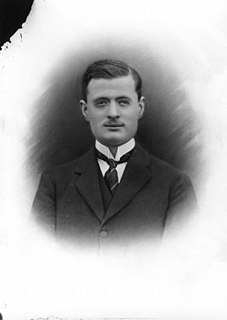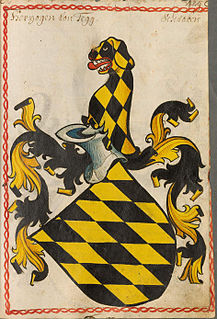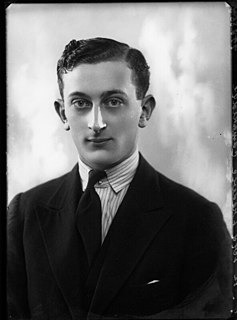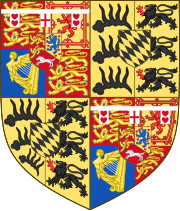
Duke of Marlborough is a title in the Peerage of England. It was created by Queen Anne in 1702 for John Churchill, 1st Earl of Marlborough (1650–1722), the noted military leader. In historical texts, unqualified use of the title typically refers to the 1st Duke. The name of the dukedom refers to Marlborough in Wiltshire.

Duke of Edinburgh, named after the city of Edinburgh, Scotland, is a substantive title that has been created three times for members of the British royal family since 1726. It does not include any territorial landholdings and does not produce any revenue for the title holder.

Marquess of Normanby is a title that has been created twice, once in the Peerage of England and once in the Peerage of the United Kingdom. The first creation came in 1694 in the Peerage of England in favour of John Sheffield, 3rd Earl of Mulgrave. He was a notable Tory politician of the late Stuart period, who served under Queen Anne as Lord Privy Seal and Lord President of the Council. In 1703 this first Marquess of Normanby was further honoured when he was made Duke of Buckingham and Normanby. These titles became extinct on the death of the 2nd Duke in 1735.
Duke of Buckingham held with Duke of Chandos, referring to Buckingham, is a title that has been created several times in the peerages of England, Great Britain, and the United Kingdom. There have also been earls and marquesses of Buckingham.

The title of Duke of Kent has been created several times in the peerages of Great Britain and the United Kingdom, most recently as a royal dukedom for the fourth son of King George V. Since 1942, the title has been held by Prince Edward, Queen Elizabeth II's cousin.

Duke of Cambridge, one of the eight current royal dukedoms in the United Kingdom as of 2021, is a hereditary title of specific rank of nobility in the British royal family. The title is heritable by male descendants by primogeniture, and has been conferred upon members of the British royal family several times.

The title of Earl of Athlone has been created three times.

Lieutenant Colonel Adolphus Cambridge, 1st Marquess of Cambridge,, born Prince Adolphus of Teck and later The Duke of Teck, was a relative of the British Royal Family, a great-grandson of King George III and younger brother of Queen Mary, the wife of King George V. In 1900, he succeeded his father as Duke of Teck in the Kingdom of Württemberg. He relinquished his German titles in 1917 to become Marquess of Cambridge.

George Francis Hugh Cambridge, 2nd Marquess of Cambridge,, known as Prince George of Teck until 1917 and as Earl of Eltham from 1917 to 1927, was a relative of the British Royal Family, a great-great-grandson of King George III and nephew of Queen Mary, the consort of King George V. He was also nephew to the 1st Earl of Athlone. He was the elder son of the 1st Marquess of Cambridge, formerly the Duke of Teck, and his wife, the former Lady Margaret Grosvenor.
Duke of Cumberland is a peerage title that was conferred upon junior members of the British Royal Family, named after the historic county of Cumberland.

Duke of Somerset, from the county of Somerset, is a title that has been created five times in the peerage of England. It is particularly associated with two families: the Beauforts, who held the title from the creation of 1448, and the Seymours, from the creation of 1547, in whose name the title is still held. The present dukedom is unique, in that the first holder of the title created it for himself in his capacity of Lord Protector of the Kingdom of England, using a power granted in the will of his nephew King Edward VI.

Duke of Atholl, alternatively Duke of Athole, named after Atholl in Scotland, is a title in the Peerage of Scotland held by the head of Clan Murray. It was created by Queen Anne in 1703 for John Murray, 2nd Marquess of Atholl, with a special remainder to the heir male of his father, the 1st Marquess.

Earl of Halifax is a title that has been created four times in British history—once in the Peerage of England, twice in the Peerage of Great Britain, and once in the Peerage of the United Kingdom. The name of the peerage refers to Halifax, West Yorkshire.

The title of Earl of Inverness was first created in 1718 in the Jacobite Peerage of Scotland, together with the titles Viscount of Innerpaphrie and Lord Cromlix and Erne, by James Francis Edward Stuart for the Honourable John Hay of Cromlix, third son of the 7th Earl of Kinnoull. He was created Duke of Inverness in 1727, but both titles became extinct upon the death of the grantee in 1740.

Earl of Munster was a title created twice, once in the Peerage of Ireland and once in the Peerage of the United Kingdom. The first creation came in 1789 in favour of Prince William, the third son of King George III. He was made Duke of Clarence and St Andrews at the same time. When William succeeded to the throne as King William IV in 1830 the titles merged with the crown.

Duke of Teck is a title which was created twice in Germanic lands. It was first borne from 1187 to 1439 by the head of a cadet line of the German ducal House of Zähringen, known as the "first House of Teck". The caput of his territory was Teck Castle in the Duchy of Swabia.
The peerage title of Viscount Launceston, named for Launceston in Cornwall, has been twice created, each time for an individual connected with the British Royal Family.

Margaret Evelyn Cambridge, Marchioness of Cambridge was the sixth child and third daughter of the 1st Duke of Westminster and the wife of the 1st Marquess of Cambridge. She was known before her marriage as The Lady Margaret Grosvenor, and after it she was also known as Princess Adolphus of Teck and later The Duchess of Teck.

Lady Helena Gibbs, born Princess Helena of Teck, was a descendant of the British royal family, great-great-granddaughter of King George III, and a niece of Queen Mary, the consort of King George V.

Lord Frederick Cambridge was a descendant of the British Royal Family. He was the younger son of Adolphus Cambridge, 1st Marquess of Cambridge, formerly the Duke of Teck, and a nephew of Queen Mary, the consort of King George V.














